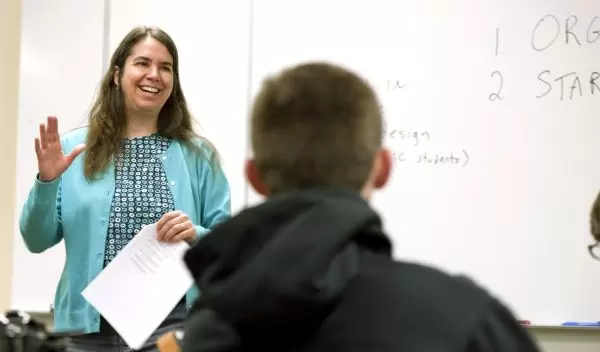
A new approach to creating a computing curriculum
Meet Maddie, a Maryland high-school freshman who has a passion for robotics, creating apps, blogging and using HTML to design webpages. She is full of enthusiasm about computing. She joins the software group of her school's robotics team and learns a programming language called C++.
Eager to continue on her path, she adds a computer science, or CS, course to her schedule for her sophomore year. As the new school year starts, she is looking forward to learning more about CS. Fast-forward 4 weeks.... Maddie is in her guidance counselor's office with a schedule change form. She's leaving the CS course and enrolling in technology education. What happened?
According to Marie desJardins, a professor of Computer Science at the University of Maryland, Baltimore County (UMBC), Maddie's story is all too common. The circumstances that led her to leave the course may vary across the 247 high schools in 24 school districts in Maryland.
A survey by the Computer Science Teachers of America revealed several factors at play including the lack of a computer science curriculum and inadequate teacher certification programs in computer science. Furthermore, computer science classes are less likely to be offered in rural and urban school districts than in suburban ones. But regardless of the reasons, the results are the same: A disproportionately low number of girls and African American, Native American, Pacific Islander and Hispanic students and persons with disabilities are taking CS classes.
DesJardins has been working to change the status quo by directing the CS Matters in Maryland Project to increase the expertise of high school teachers for teaching computer science. The project is part of a larger initiative, CS 10K, supported by the National Science Foundation (NSF).
Since 2008, NSF has led the "CS 10K" effort and has funded researchers to develop new curricula with the goal of training 10,000 teachers to teach computer science in 10,000 schools across the nation. More recently, NSF's partners have agreed to expand this goal to include all U.S. schools.
"I believe that CS should be included throughout the K-12 curriculum as a set of basic skills and knowledge for today's world," desJardins said. "All citizens of the 21st century, especially the next generation of knowledge workers, will benefit greatly from learning about computational thinking and the problem-solving skills that are a core part of computer science."
The CS 10K Maryland Project team working with desJardins includes: Jan Plane, senior lecturer in the Computer Science Department at the University of Maryland College Park (UMCP); Dianne O'Grady-Cunniff, Westlake High School, Charles County; Joe Greenawalt, North Point High School, Charles County and Christina Morris, Catonsville High School, Baltimore County.
Their approach to improving the CS education landscape in Maryland employs a collaborative process in which CS high-school teachers work together to write the curriculum. This differs from efforts that use professional curriculum writers in that in the final product, it integrates the perspectives, pedagogical expertise and in-the-actual-classroom experiences of a diverse group of teachers.
This year the team assembled a cohort of master teachers from nine public and private school systems in Maryland and the District of Columbia to create a complete curriculum package for a new College Board Advanced Placement (AP) course called CS Principles. The teachers are piloting the new curriculum this school year. During its first semester, they are capturing the experiences of the teachers and will modify the course this spring accordingly.
In 2015, desJardins and her team will offer one workshop at UMBC and another at UMCP to train 30 additional teachers to pilot the new curriculum. In 2016, they aim to partner with four training sites across Maryland and the District of Columbia and to train 80 additional teachers to offer the course during the 2016-17 school year--the first year in which the AP CS Principles exam is scheduled to be offered.
To scale up these efforts across the nation, desJardins says, we should be focusing on four near-term goals: creating appealing and engaging curriculum materials for K-12 students, training teachers to deliver this material effectively to a diverse population of learners, providing all students with access to these courses and making sure that CS counts towards high school graduation.
Though this story focuses on the state of computer science education in Maryland, trends nationwide are similar. Currently, only 25 states allow computer science to count as a mathematics or science credit towards graduation.
Through the CS 10K project, the efforts of desJardins, other researchers and NSF's partners are making computer science education more accessible in K-12 schools across the country.


